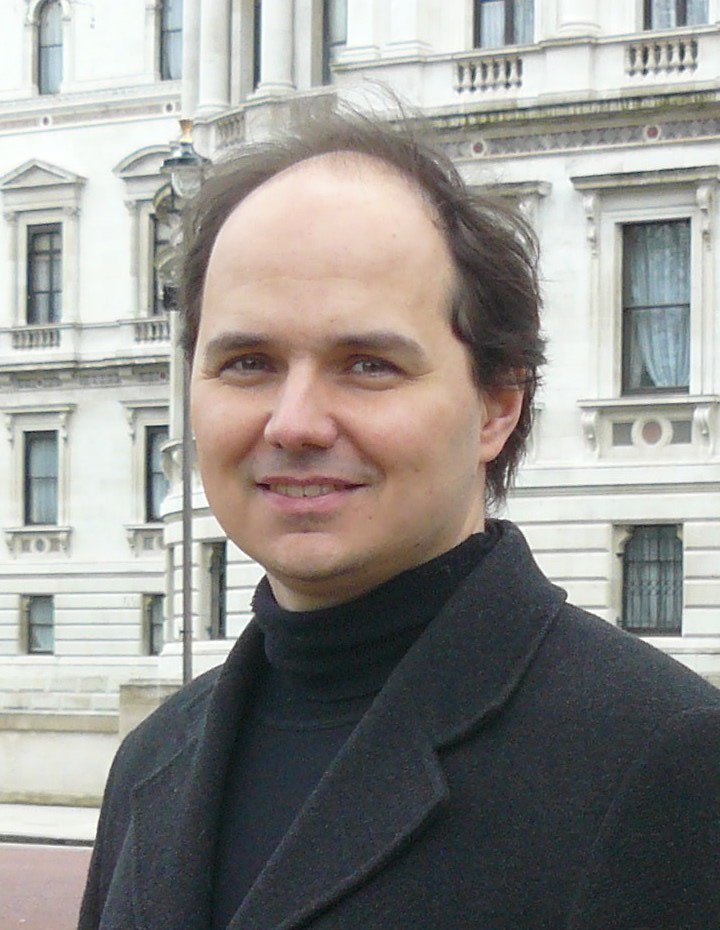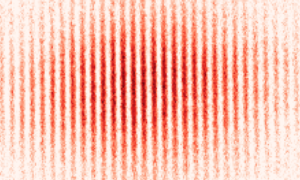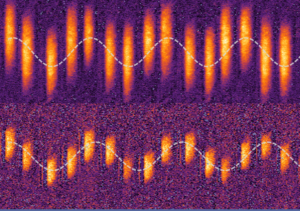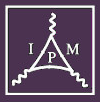
- Head of the doctoral school Physique en Ile de France (EDPIF)
- Professor at l’Ecole normale supérieure
- Adjunct professor (professeur chargé de cours) at l’Ecole polytechnique
- Senior member of Institut Universitaire de France.
I study theoretical and experimental aspects of quantum and classical fluids and my interests range from quantum simulation of many-body physics using ultracold atoms to the study of interfacial hydrodynamics.
Contact
E235
01443232 56
Laboratoire de physique
de l’Ecole normale supérieure
24 rue Lhomond 75005 PARIS
Download full CV: CVEnglish
Full publication list: Google Scholar
Research interests
Ultracold atoms
One-dimensional fermions (in collaboration with Giuliano Orso (MPQ))
 The physics of quantum many-body systems strongly depends on their dimensionality. Thus, in one-dimensions, the strong topological constraints imposed by the small number of degrees of freedom result in a behavior radically different from that observed in three dimensions: among the most emblematic examples, we can cite the integrability of these systems, ie the existence of an infinity of constants of motion preventing relaxation towards the state of thermodynamic equilibrium and requiring a profound reformulation of their dynamic properties. At the microscopic level, the elementary excitations are not fermionic objects (as in the Fermi Liquid theory describing 3D fermions) but collective bosonic excitations forming a so-called Luttinger liquid. From the macroscopic point of view, it was shown that long wavelength excitations of integrable systems could be described by a generalized version of the laws of classical hydrodynamics.
The physics of quantum many-body systems strongly depends on their dimensionality. Thus, in one-dimensions, the strong topological constraints imposed by the small number of degrees of freedom result in a behavior radically different from that observed in three dimensions: among the most emblematic examples, we can cite the integrability of these systems, ie the existence of an infinity of constants of motion preventing relaxation towards the state of thermodynamic equilibrium and requiring a profound reformulation of their dynamic properties. At the microscopic level, the elementary excitations are not fermionic objects (as in the Fermi Liquid theory describing 3D fermions) but collective bosonic excitations forming a so-called Luttinger liquid. From the macroscopic point of view, it was shown that long wavelength excitations of integrable systems could be described by a generalized version of the laws of classical hydrodynamics.
In this context, our group has succeeded in making tubes of quasi-one-dimensional fermionic atoms and imaging them individually (see figure opposite). This gives access to a quantitative characterization of the properties of these systems.
Related publications:
In Situ Thermometry of Fermionic Cold-Atom Quantum Wires C De Daniloff, M Tharrault, C Enesa, C Salomon, F Chevy, T Reimann, J. Struck, Physical Review Letters 127 (11), 113602 (2022)
Quantum impurities (in collaboration with C. Salomon and X. Leyronas)
 The problem of an impurity immersed in an ensemble of interacting particles is one of the simplest, though on trivial, examples of the quantum many-body problem. This problem was first studied by Landau and Pekar in their study of the coupling of an electron to the excitations of a crystal lattice. More recently, cold atoms have demonstrated their ability to produce a wide range of experimental systems in which several embodiments of these impurity problems can be studied experimentally in a perfectly controlled environment. The fermionic polaron, corresponding to an impurity immersed in a sea of fermions without interactions, could thus be studied in detail and served as a prototype for the study of other impurity problems with ultracold atoms. Subsequent study of the bosonic polaron (an impurity immersed in a Bose-Einstein condensate) further highlighted the role of three-body interactions. Finally, more recently we have explored the properties of an impurity coupled to an attractive fermionic gas and we have shown that this problem intersects between fermionic and bosonic polarons.
The problem of an impurity immersed in an ensemble of interacting particles is one of the simplest, though on trivial, examples of the quantum many-body problem. This problem was first studied by Landau and Pekar in their study of the coupling of an electron to the excitations of a crystal lattice. More recently, cold atoms have demonstrated their ability to produce a wide range of experimental systems in which several embodiments of these impurity problems can be studied experimentally in a perfectly controlled environment. The fermionic polaron, corresponding to an impurity immersed in a sea of fermions without interactions, could thus be studied in detail and served as a prototype for the study of other impurity problems with ultracold atoms. Subsequent study of the bosonic polaron (an impurity immersed in a Bose-Einstein condensate) further highlighted the role of three-body interactions. Finally, more recently we have explored the properties of an impurity coupled to an attractive fermionic gas and we have shown that this problem intersects between fermionic and bosonic polarons.
Related publications:
Experimental works:
- Connecting few-body inelastic decay to quantum correlations in a many-body system: A weakly coupled impurity in a resonant Fermi gas, S. Laurent, M. Pierce, M. Delehaye, T. Yefsah, F. Chevy, C. Salomon Physical Review Letters 118 (10), 103403 (2017)
- Critical velocity and dissipation of an ultracold Bose-Fermi counterflow, M. Delehaye, S. Laurent, I. Ferrier-Barbut, S. Jin, F. Chevy, C. Salomon
Physical review letters 115 (26), 265303 (2015)
- A mixture of Bose and Fermi superfluids, I. Ferrier-Barbut, M. Delehaye, S. Laurent, A.T. Grier, M. Pierce, B.S. Rem, F. Chevy, C. Salomon,
Science 345 (6200), 1035-1038 (2014)
Theoretical works:
- Mean field versus random-phase approximation calculation of the energy of an impurity immersed in a spin-1/2 superfluid , A. Bigué, F. Chevy, X. Leyronas; Physical Review A 105 (3), 033314 (2022)
- Impurity immersed in a double Fermi sea, R. Alhyder, X. Leyronas, F. Chevy, Physical Review A 102 (3), 033322 (2020)
- Few Versus Many-Body Physics of an Impurity Immersed in a Superfluid of Spin Attractive Fermions, M. Pierce, X. Leyronas, F. Chevy
Physical Review Letters 123 (8), 080403 (2019)
Quantum transport
- Topological systems (with D. Wilkowski, NTU Singapore): it is possible to take advantage of light-matter interaction to synthesize artificial gauge fields. In a uniform non-abelian gauge field, the spin-orbit coupling between the internal and external degrees of freedom of a particle results in a trembling motion of the latter (Zitterbewegung) which has been observed and characterized experimentally.
- Transport in optical lattices (with J.H. Thywissen, Toronto): ultracold atoms trapped in optical lattices make it possible to experimentally reproduce the Fermi-Hubbard model, which many consider holds the answers to the enigmas posed for more than thirty years by superconductivity at high critical temperature. Ultracold atoms also make it possible to reach regimes that are inaccessible in condensed matter, for example temperatures so high that a normal crystal would melt. It is this regime that the group of J.H. Thywissen from Toronto studied experimentally and that we were able to characterize using a kinetic theory.
- Relativistic systems: we showed that the dynamics of atoms confined in a quadrupolar magnetic potential was equivalent to that of ultrarelativistic particles (without masses) confined in a harmonic potential. Unlike classical physics where the motion of the center of mass oscillates indefinitely, the motion of a massless particle is damped due to the structure of its dispersion relationship. Due to the absence of collisions, however, the relaxation takes place towards a non-thermal state retaining the memory of the direction of the initial excitation.
- Landau’s criterion revisited: one of the signatures of superfluidity is the existence of a critical velocity above which dissipation reappears. The existence of this critical velocity was first predicted by Landau who showed that for a weak mobile impurity, it was equal to the minimum of the phase velocity of the excitations propagating in the superfluid. Nevertheless, this argument is based on strong assumptions (homogeneity of the system, constant displacement speed of the impurity) and we have shown that in practice these were rarely satisfied experimentally which results in strong deviations from Landau’s original prediction.
Related publications:
Topological systems
- Anisotropic Zitterbewegung Dynamics in Synthetic Non-Abelian Gauge Fields, M. Hasan, C. S. Madasu, K. D. Rathod, C. C. Kwong, C. Miniatura, F Chevy, D. Wilkowski, arXiv preprint arXiv:2201.00885 (2022)
- Non-Abelian adiabatic geometric transformations in a cold strontium gas, F Leroux, K Pandey, R Rehbi, F Chevy, C Miniatura, B Grémaud, …
Nature communications 9 (1), 1-7 (2018)
Conductivity in optical lattices
- Conductivity spectrum of ultracold atoms in an optical lattice, R. Anderson, F. Wang, P. Xu, V. Venu, S. Trotzky, F. Chevy, J.H. Thywissen
Physical Review Letters 122 (15), 153602 (2019)
Dissipation is relativistic systems without interactions
- Quasithermalization of collisionless particles in quadrupole potentials, J. Lau, O. Goulko, T. Reimann, D. Suchet, C. Enesa, F. Chevy, C. Lobo
Physical Review A 101 (3), 033605 (2020)
- Analog simulation of Weyl particles with cold atoms, D Suchet, M Rabinovic, T Reimann, N Kretschmar, F Sievers, C Salomon, F. Chevy
EPL (Europhysics Letters) 114 (2), 26005 (2016)
Landau’s criterion revisited
- Hydrodynamic response of a trapped superfluid to a periodic perturbation S Jin, S Laurent, F Chevy The European Physical Journal Special Topics 227 (15), 2263-2273 (2019)
- Hydrodynamic spectrum of a superfluid in an elongated trap, P.P. Crépin, X. Leyronas, F. Chevy EPL (Europhysics Letters) 114 (6), 60005 (2016)
- Counter-flow instability of a quantum mixture of two superfluids, M. Abad, A. Recati, S. Stringari, F. Chevy, The European Physical Journal D 69 (5), 1-5 (2015)
Review on atomtronics
- Roadmap on Atomtronics: State of the art and perspective, L. Amico, et al., AVS Quantum Science 3 (3), 039201 (2021)
Classical physics

- The phantom glass (with Lydéric Bocquet): this phenomenon sometimes occurs when a glass is placed near the hand-washed sink. As illustrated by numerous Youtube videos, the glass begins to move spontaneously, as if moved by an invisible force. We have shown that this effect comes from a loss of adhesion of the glass caused by the appearance of a capillary bridge isolating it from the surface on which it is placed.
- The cobra wave (with Christophe Clanet): it is a non-linear wave propagating along a lattice of cleverly intertwined rods. The lattice rises thanks to the momentum provided by the ejection of the rods and its profile can be deduced from a continuous model constructed from the mechanical properties of the sticks. In particular, the speed of the wave is up to a geometric factor proportional to the speed of sound in the material constituting them.
Related publications:
- Popsicle-stick cobra wave, J.P. Boucher, C. Clanet, D. Quéré, F. Chevy Physical Review Letters 119 (8), 084301 (2017)
Teaching
- L3 FIP : relativité et électromagnétisme – accessible en ligne sur la chaîne Youtube du département de physique
- M1 ICFP : symmetries in physics (2019/23), lecture notes
- M2 ICFP : advanced quantum mechanics
- 2èm année du cycle ingénieur polytechnicien; PC d mécanique quantique avancée
- 2èm année du cycle ingénieur polytechnicien; PC d’électromagnétisme










